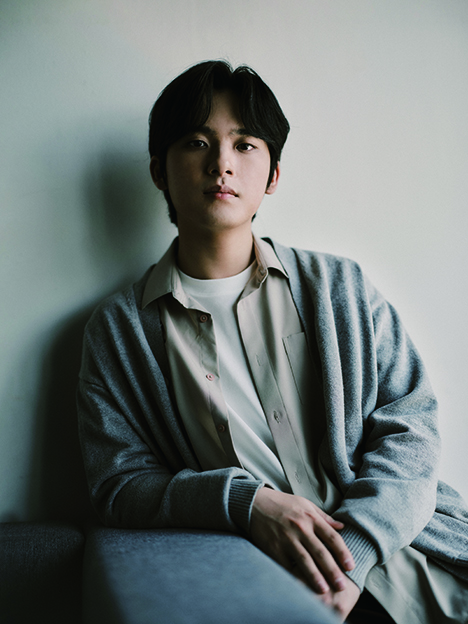노먼 레브레히트칼럼|SINCE 2012
영국의 평론가가 보내온 세계 음악계 동향
‘초월’의 연주자, 다비드 오이스트라흐
방대한 워너 클래식스 전집(2024) 출반에 대한 감상
 나의 한 달은 어디로 가버렸을까? 역사상 가장 매력적이었던 바이올리니스트의 거대한 CD 전집을 공략하느라 대부분의 시간을 써버렸다. 구소련의 오데사 출신인 다비드 오이스트라흐(1908~1974)는 소련 바이올린 연주의 기틀을 마련한 이로, ‘주요한 인물’이라는 말만으로는 그를 수식하기에 부족하다.
나의 한 달은 어디로 가버렸을까? 역사상 가장 매력적이었던 바이올리니스트의 거대한 CD 전집을 공략하느라 대부분의 시간을 써버렸다. 구소련의 오데사 출신인 다비드 오이스트라흐(1908~1974)는 소련 바이올린 연주의 기틀을 마련한 이로, ‘주요한 인물’이라는 말만으로는 그를 수식하기에 부족하다.
바이올린을 위해 태어난 사람
20세기 중반 소련 모스크바에서는 피아니스트의 수가 급증했다. 스뱌토슬라프 리흐테르(1915 ~1997)와 에밀 길렐스(1916~1985), 마리아 유디나(1899 ~1970)와 타티야나 니콜라예바(1924~), 야코프 플리에르(1912~1977)와 야코프 자크(1913~1976), 네이가우스 부자가 같은 밤 공연할 때, 딱 하나만 선택해야 한다고 상상해 보라. 불가능한 선택이다.
바이올리니스트의 경우라면 선택은 훨씬 쉬워진다. 우선 다비드 오이스트라흐(1908~1974)가 있고, 그 뒤를 잇는 무리가 있다. 후자는 대부분 오이스트라흐의 제자로, 올레크 카간(1946~1990), 기돈 크레머(1947~), 리디아 모르드코비치(1944~2014), 니나 벨리나, 스토이카 밀라노바(1945~2024), 그리고 오이스트라흐의 아들 이고르(1931~2021) 등이 여기에 해당한다. 제한된 집단 이데올로기 속에서 오이스트라흐는 제자들이 자신만의 독창성을 갖도록 가르쳤다. 무대에 오른 오이스트라흐의 모습은 완전한 평정의 목도였다.
비유하자면 리흐테르는 연주를 할 수도 있고 안 해도 되는 일인 듯이 피아노에 다가갔고, 길렐스는 당의 승인을 확인하고자 영원히 어깨너머만 바라보았다. 한편, 오이스트라흐는 턱 밑으로 바이올린을 당겨 넣고는 연주를 하기 위해 태어난 사람처럼 연주했다. 그를 전적으로 신뢰하지 않았던 당에서는 아들 이고르부터 먼저 서방 투어를 보냈다. 오이스트라흐가 마침내 미국 카네기홀 무대에 섰을 때, 공허한 비르투오시티에 지쳐 있던 관객에게 그는 뜻밖의 발견이었다. 대기실에는 그와 인사하기 위해 배우 마릴린 먼로, 그 뒤에 바이올리니스트 프리츠 크라이슬러가 기다리고 있었다. 그들 모두를 순종 없이 맞았던 오이스트라흐는 권위 그 자체였다.
침묵하는 자 뒤에 숨겨진 인류애

로스트로포비치, 오이스트라흐, 브리튼, 쇼스타코비치
이전 EMI 녹음과 모스크바 방송분이 모두 포함된 워너(Warner)의 기념비적인 전집은 CD 58장, DVD 3장에 이른다. 한번 개봉하면 음악만 듣는 분신을 만들고 싶어질 만큼 위험하고, 매혹적이다. 리흐테르의 회고담을 쓴 영화감독 브뤼노 몽생종(1943~)이 컴필레이션을 주도했으며, DVD의 전기 다큐멘터리도 맡았다. 그러나 다비드 오이스트라흐의 심장에 가닿는 일은 결코 쉽지 않다.
소련에서 그는 모두에게 깍듯하나 속은 내보이지 않았기에 추측 또한 무의미하다. 그가 다가가기 결코 쉽지 않은 쇼스타코비치(1906~1975)보다 그랜드마스터 체스 상대인 프로코피예프(1891~1953)와 더 가까웠을 것이라는 수준의 추측을 할 수는 있겠다. 그러나 오이스트라흐가 눈부신 직관으로 두 사람의 협주곡을 연주하는 모습을 보면, 그가 무엇보다 충성한 대상은 음악이었다고 추론할 수 있다. 이 전집에 포함된 소나타보다 바인베르크(1919~1996)의 곡을 연주한 음반이 더 많을 수 있지만 정작 오이스트라흐 본인의 이유는 알 길이 없다. 바인베르크가 KGB 정보원이었던 레오니드 코간(1924~1982)에게 협주곡의 첫 연주 기회를 준 사실에 분개했을지도 모른다. 바인베르크에게 선택의 폭이 넓지는 않았다. 이 세 사람 모두 소련의 반유대주의를 경험했다.
비판적으로 꼬집자면 이 오이스트라흐로 가득한 전집에 결점이 없지는 않다. 1938년 차이콥스키 협주곡 연주는 마치 사포에 녹음한 듯 들리지만, 전에는 들어본 적 없는 한 악절을 연주했기에 전집에 담겼다. 아마도 바이올린의 절대적 스승 레오폴드 아우어(1845~1930)가 준 영감에서 비롯됐을 것이다. 냉혈한의 심장마저 녹일 오이스트라흐의 인류애가 돋보이며 키릴 콘드라신(1914~1981)이 지휘한 차이콥스키 ‘우울한 세레나데’로 불편함은 눈 녹듯 씻어 내린다.
그 역시 크라이슬러, 타르티니, 짐발리스트 등 다소 현란한 곡을 선택하기도 했으나, 1955년 10월의 슈베르트 8중주는 놀라운 고요를 품고 있다. 스튜디오의 유일한 스타였던 오이스트라흐는 격동의 한 해 동안 오케스트라 연주자들과 힘을 모아 한 시간짜리 초월을 선사했다. 두 프로코피예프 협주곡에 대해 세계 체스 챔피언 미하일 보트빈니크는 프로코피예프와 오이스트라흐만큼 “연주 스타일에서 이 정도 대조를 보이는 경우는 없다”라고 언급했다. 보트빈니크는 프로코피예프를 전(前)혁명적인 모험주의자로 그렸다면, 오이스트라흐는 “그보다 더욱 인내심과 세심함을 겸비한 인물”로 구체화했다. 수많은 체스 전략처럼 이 역시 절반은 환상일지도 모르겠다.
거장의 개성
 오이스트라흐의 연주는 간단하게 분류할 수 없다. 엄숙한 힌데미트 협주곡에는 예상치 못한 삶의 입맞춤을 불어넣는다. 세자르 프랑크의 소나타가 바이올리니스트의 성품을 시험하는 최고 권위의 시험대라면, 오이스트라흐는 자신의 피아니스트 블라디미르 얌폴스키(1905~1965)를 거의 동등하게 승격시킨다. 레프 오보린(1907~1974)과 함께 한 베토벤의 크로이처 소나타에서도 이는 마찬가지이다. 베토벤의 삼중 협주곡은 두 가지 버전을 들을 수 있다. 악명 높은 카라얀/베를린필과 함께한 리흐테르·로스트로포비치 버전, 그리고 전설적인 컬래버레이션이었던 1958년 런던의 말콤 사전트/필하모니아 오케스트라와 함께한 레프 오보린·스뱌토슬라프 크누셰비츠키(1908~1963) 버전.
오이스트라흐의 연주는 간단하게 분류할 수 없다. 엄숙한 힌데미트 협주곡에는 예상치 못한 삶의 입맞춤을 불어넣는다. 세자르 프랑크의 소나타가 바이올리니스트의 성품을 시험하는 최고 권위의 시험대라면, 오이스트라흐는 자신의 피아니스트 블라디미르 얌폴스키(1905~1965)를 거의 동등하게 승격시킨다. 레프 오보린(1907~1974)과 함께 한 베토벤의 크로이처 소나타에서도 이는 마찬가지이다. 베토벤의 삼중 협주곡은 두 가지 버전을 들을 수 있다. 악명 높은 카라얀/베를린필과 함께한 리흐테르·로스트로포비치 버전, 그리고 전설적인 컬래버레이션이었던 1958년 런던의 말콤 사전트/필하모니아 오케스트라와 함께한 레프 오보린·스뱌토슬라프 크누셰비츠키(1908~1963) 버전.
알세오 갈리에라(1910~1996), 앙드레 클뤼이탕스(1905~1967), 장 마르티농(1910~1976), 니콜라이 말코(1883~1961), 식스텐 엘링(1917~2005) 등 EMI 지휘자들의 효험을 곱씹느라 나는 자주 음반을 멈췄다. 이 과소평가된 거장들로부터 배울 점은 아주 많다. 또한 조지 셀(1897~1970)과 오토 클렘페러(1885~1973)는 브람스 협주곡에서 오이스트라흐를 다루는 데에 있어 양분된 접근법을 보인다.
시벨리우스는 본인의 협주곡에서 오이스트라흐의 “비상한 개성”을 찬미하는 편지를 보냈다. 윌리엄 월튼은 그를 “최고”라 칭했고, 쇼스타코비치는 ‘도디크’(어린 시절 애칭)로 불렀다. 오이스트라흐에게 가장 선호하는 작곡가가 있다면 브람스가 유력하다. 생의 마지막 날인 1974년 10월 24일, 그는 네덜란드 암스테르담에서 로열 콘세르트허바우 오케스트라와 브람스의 2중 협주곡을 리허설하고 교향곡 3번을 지휘했다. 그의 친우가 말해준 바로는 그 주에 오이스트라흐는 소련을 떠나 이스라엘로 이주하는 것을 비밀리에 논의하고 있었다고 한다. 그 의도야 어떻든, 오이스트라흐는 이 위대한 보물 음악 전집 안에 계속 살아 있다. 그 어느 때보다, 그 무엇보다 확실한 뜻밖의 발견이다.
번역 evener
노먼 레브레히트 칼럼의 영어 원문을 함께 제공합니다.
본 원고는 본지의 편집 방향과 일치하지 않을 수 있습니다.
Where has my month gone? Much of it was spent plundering a monster CD box of one of the most captivating violinists that ever lived. David Oistrakh, Odessa born, set the tone for violin playing in the Soviet Union. Dominant doesn’t begin to describe him.
Pianists proliferated in mid-century Moscow. Imagine having to choose on the same night between Sviatoslav Richter and Emil Gilels, Yudina and Nikolaeva, Flier and Zak, Neuhaus father and son. Impossible choices.
With violinists, it was easier. There was Oistrakh, and then there were the rest, many of them his students – Oleg Kagan, Gidon Kremer, Lydia Mordkovich, Nina Belina, Stoika Milanova, and more, not to mention his own son, Igor. Oistrakh taught them, within the limits of a collective ideology, to be themselves. To see Oistrakh on stage was to witness total composure.
Richter would approach the piano as if playing it was something he might, or might not, do. Gilels was forever looking over his shoulder – metaphorically – to see if the Party approved. Oistrakh tucked the violin beneath his chin and played as if that was what he was born to do. The Party, never fully trusting him, sent Igor out first to tour the west. When David finally walked on stage at Carnegie Hall he was a revelation to audiences jaded by empty virtuosity. Backstage, he found Marilyn Monroe first in line to greet him. Behind her was Fritz Kreisler. Oistrakh received them without deference. He was authority incarnate.
Warner’s monumental box of ex-EMI recordings and Moscow radio tapes – 58CDs and 3DVDs – is dangerously absorbing, if you want to have any other life once you have opened it. The selection was directed by Bruno Monsaingeon, Richter’s chronicler, who also contributes a DVD bio-doc. Getting to the heart of David Oistrakh is no easy task.
In the Soviet Union, Oistrakh was polite to everyone, giving nothing away. Speculation is pointless. One might surmise, for instance, that he was closer to Sergie Prokofiev, his fellow-chess grandmaster, than to Dmitri Shostakovich, never the most approachable of men. But hearing him perform both men’s concertos with dazzling intuition all one can conclude is that his loyalty, first and last, is to the music. There may be bigger recordings of him playing Mieczyslaw Weinberg than the sonata in this set, but we cannot know Oistrakh’s reasons; perhaps he resented Weinberg letting Leonid Kogan, a KGB informer, have first crack at his concertos. Not that Weinberg had much choice. All three were exposed to Soviet anti-semitism.
Critically speaking, this Oistrakh cornucopia is not without flaws. A performance of the Tchaikovsky concerto from 1938 sounds like it was recorded on sandpaper; it is included because Oistrakh plays a passage previously unheard – possibly an inspiration of the supreme violin teacher, Leopold Auer. No matter: any discomfort is eased by a Sérénade mélancolique, conducted by Kirill Kondrashin, in which Oistrakh’s humanity could melt a heart of stone.
He does flashy bits, too, dollops of Kreisler, Tartini and Zimbalist. A Schubert Octet, dated October 1955, has an astonishing serenity. Oistrakh, the only star name in the studio, mucks in with orchestral players to produce an hour of transcendence in a year of Kremlin chaos. In the two Prokofiev concertos, we hear from the world chess champion Mikhail Botvinnik that ‘there could be no greater contrast in the style of playing’ than between Prokofiev and Oistrakh’. Prokofiev, says Botvinnik, personified pre-Revolutionary adventurism, Oistrakh ‘was more patient and prudent’. Like many chess gambits, this may be more than half-illusory.
Oistrakh’s playing of music is not easily categorise. There is an austere Hindemith concerto to which he gives, unexpectedly, the kiss of life. If the César Franck sonata is a supreme test of a violinist’s personality, Oistrakh elevates his pianist Vladimir Yampolsky to near equality. He does the same in Beethoven’s Kreutzer Sonata with Lev Oborin. The Beethoven triple concerto is heard in two versions – the notorious Berlin one with Richter, Rostropovich and Karajan, and a 1958 London account, conducted by Malcolm Sargent, with Oborin, the cellist Sviatoslav Knushevitsky and the Philharmonia Orchestra, a collaborative masterclass.
Time after time, I paused a recording to reflect upon the efficacy of EMI’s conductors – Alceo Galliera, Andre Cluytens, Jean Martinon, Nikolai Malko, Sixten Ehrling. There is much to learn from these underrated masters. And then there’s George Szell and Otto Klemperer, who deliver a pair of dichotomous approaches to managing Oistrakh in the Brahms concerto. Sibelius wrote him a letter praising his ‘extreme individuality’ in his concerto. William Walton named Oistrakh ‘the best’. Shostakovich called him ‘Dodik’. If he had a favourite composer, it was possibly Brahms. The day he died, October 24, 1974, he rehearsed the Brahms double concerto and conducted the third symphony with the Concertgebouw Orchestra in Amsterdam. One of his closest friends told me that, in the same week, he was secretly discussing leaving the Soviet Union and moving to Israel. Oistrakh, whatever his intentions, lives on in this great box of musical treasures. The revelation is as compelling as ever.
글 노먼 레브레히트 영국의 음악·문화 평론가이자 소설가. ‘텔레그래프’지, ‘스탠더즈’지 등 여러 매체에 기고해왔으며, 지금 이 순간에도 자신의 블로그(www.slippedisc.com)를 통해 음악계 뉴스를 발 빠르게 전한다







